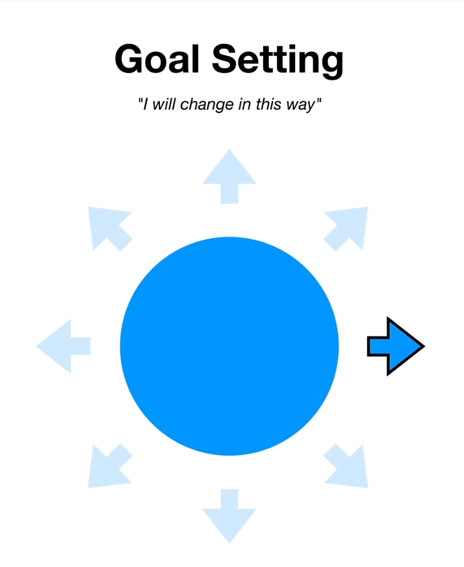What is a Growth Mindset?
One of the most powerful mindset shifts you can make is to decide to embrace a growth mindset. For some, this is a radical change as they’ve become accustomed to a fixed mindset, or a limited view of their potential. But in order to reach your full potential, you have to make the switch and believe not only that growth is possible, but that you have the ability to direct it where you want to go.
Let’s break down the differences between a fixed mindset and growth mindset.

People with a fixed mindset believe that they are who they are, and there’s not much if anything they can do to change that. People with a fixed mindset believe they were born with certain talents or abilities, and while they may discover things over time, they really can’t change who they are. Since they can’t really change who they are, they get upset when confronted with failure because they view their failure as a judgment that they aren’t good enough as a person. They don’t realize that everyone fails sometimes, and they do whatever they can to avoid these situations, including making up excuses, projecting blame on other people, and lashing out emotionally at people and circumstances that challenge their idea of who they are and what they are good at.

People with a growth mindset have a completely different attitude towards failure. Because people with a growth mindset believe that they are always changing, they view failure as an opportunity to learn and improve. They view failure as a teacher, and try to glean as much wisdom and insight from the fact that they weren’t successful to do better next time. It’s a much healthier approach to learning.

But you can take the concept of a growth mindset even further by applying it in a specific direction. If you have a growth mindset and believe who you are is always changing, the next step is to channel that belief in the direction that you want to grow. You don’t need to simply accept whatever life throws in your lap and hope to do the best with it – you can choose the direction you want to grow and define who you want to become. There are obviously limits with this, but they aren’t as significant as you might think. There are even examples of people who have never played a sport before embracing a growth mindset to become a professional through a concept called *deliberate practice*. In his book, Peak, Dr. Anders Ericsson defines deliberate practice as “purposeful practice that knows where it is going and how to get there.” It’s pushing yourself to get better at something by practicing one small aspect of it in order to become excellent at it. Using this approach, coupled with the practice of goal setting, is powerful, because it means that you have the ability to not only visualize, but to actually create, your ideal future.
4 Common Misconceptions about Growth Mindset
Growth mindset has become a bit of a buzzword as of late. But knowing about something and truly understanding it are two very different things. Here are a couple of common misconceptions people have when it comes to comprehending what growth mindset really means.
#1: A growth mindset is not just what you like about yourself.
Many people take what they like about themselves and call it a growth mindset. But even positive traits aren’t necessarily evidence of a growth mindset. In fact, focusing only on the positive may actually be an indication of a fixed mindset. A growth mindset tends to look for the negative things so that they can be improved. They aren’t afraid to admit their deficiencies, so they look for and notice the things that are wrong in order to correct them.
#2: Growth mindset is not just about effort.
Many people believe a growth mindset is only about the effort. The tendency is to praise the effort, regardless of the outcome. But the outcome is important. Without looking at the outcome, you can’t accurately assess whether or not what you tried was successful. It’s not just about the effort; it’s also about the strategy. A growth mindset is not afraid to say, “That didn’t work,” and try again. If you find yourself tending to focus on the effort and ignoring the outcome, you may soon find yourself stuck. Effort is commendable, but it needs to be tied to the outcome.
#3: Growth mindset is not the same as saying you can do anything.
Many people believe fostering a growth mindset in others means telling them, “You can do anything.” But this isn’t quite accurate. It is true that a growth mindset will cause you to try things you wouldn’t have otherwise, but that isn’t the same as having all options available to you. Since a real growth mindset is mindful of the outcome, it’s not afraid to say, “That didn’t work,” and walk away when it recognizes that a particular strategy doesn’t work. Shutting down certain options isn’t scary to people with a growth mindset because they know it’s only a matter of time before they really find the thing that works.
#4: A growth mindset is not binary.
Growth mindset is complicated. Even if you fully grasp what it is, no one has a growth mindset 100% of the time. Mindset author Carol Dweck calls the tendency to say, “I have a growth mindset,” instead of embarking on the long and difficult journey to cultivate it, a false growth mindset. The truth is, we all struggle with a fixed mindset from time to time. It’s important to understand what things act as triggers for you and cause you to slip back into a fixed mindset so you can try to avoid them in the future.
7 Ways to Develop a Growth Mindset
A growth mindset is critical for achieving personal and professional success. You have to believe that growth is possible and that you can choose the direction you want to change.
Here are 7 tips for helping you cultivate a growth mindset and reach your full potential.
#1: Learn to view challenges as opportunities.
Challenge is the doorway to growth. Instead of being frustrated when things are difficult, learn to view the obstacle in your path as the way to personal growth. It’s just part of the journey, and gives you an opportunity to test your mettle. A challenge is simply an opportunity to overcome an obstacle.
#2: Value the process, not the results.
Instead of looking at the goal you want to achieve, focus on the habits that will get you there. Think about it like starting an exercise habit. If you start exercising with the goal of losing weight, based on statistics, you’ll probably give up. But if you learn to love the challenge of pushing yourself beyond your limits, you’ll lose the weight easily, simply because you’re motivated to show up every day. If you learn to love the process, the score will take care of itself.
#3: Do hard things.
One of the easiest ways to stretch yourself is to try and do things that are just beyond your current capabilities. By trying something that is hard, you force yourself outside of your comfort zone and to try things that don’t come to you naturally. A habit of consistently trying things that hard will help you develop your abilities beyond the limits that have become familiar for you. You might just be surprised at what you’re capable of – even if you can’t see it yet.
#4: Add the word “yet” to the end of the sentence.
One of the defining characteristics of people with a fixed mindset is that they use the statement, “I can’t do X.” But people with a growth mindset believe they have the ability to change and learn what they need to go to the next level. So the next time you find yourself saying, “I can’t do X,” change it and say, “I can’t do X yet.” A positive confession by people with a growth mindset will inspire them to try things that people with a fixed mindset think are impossible.
#5: Connect your action to purpose.
Motivation can be a tricky thing. But if you connect what you are doing to a higher calling or purpose, it can provide the motivation you need to follow through on the things that are important to you. That’s why purpose is stronger than passion when it comes to taking consistent action. In the words of Mike Rowe, “Don’t follow your passion – but always bring it with you.”
#6: Prioritize learning over winning.
People with a growth mindset are obsessed with winning. They view it as a validation that they are good enough. But people with a growth mindset aren’t worried about losing because it’s not a personal attack on their character. They learn from their losses and make changes so that they can have a better chance of winning in the future. If you take this approach every time that you fail, it won’t be long before you start succeeding.
#7: Maintain a positive attitude.
One of the things that helps foster a growth mindset is a positive attitude. You can’t always control what happens to you, but you can control how you respond to it. You can get mad that something you think is unfair happened, or you can choose to rise above it by maintaining a positive attitude. Your attitude determines your altitude, or what level you are going to live at. You’ll go much higher (and farther) if you learn to maintain a positive attitude.
Growth Mindset Ebook
If you want some help developing your own growth mindset, download our growth mindset ebook.
